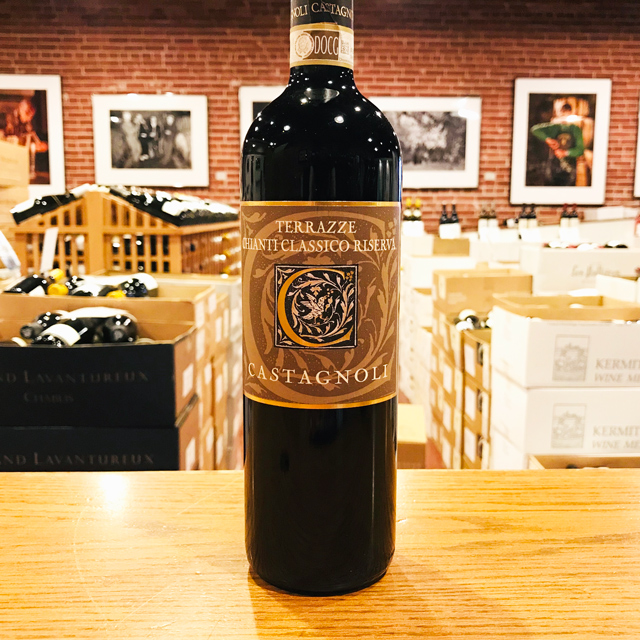Notify me
2015 Chianti Classico Riserva “Terrazze”
Castagnoli
Put this Chianti in your cellar alongside your favorite Bandols, Barolos, and Cornas. In a perfectly ripe vintage, the wine retains nuanced, exotic aromatics and lively acidity thanks to the vines’ elevation high on steep slopes strewn with flaky blue galestro, one of Sangiovese’s favorite soils. Exuberant and fine-grained, this Chianti will impress right away but will truly reward patience as fruit, tannin, and acid meld into an old-school Tuscan classic.
—Anthony Lynch
| Wine Type: | red |
| Vintage: | 2015 |
| Bottle Size: | 750mL |
| Blend: | Sangiovese |
| Appellation: | Chianti Classico Riserva |
| Country: | Italy |
| Region: | Tuscany |
| Producer: | Castagnoli |
| Winemaker: | Alfred Schefenacker |
| Vineyard: | 10 years average, 6.53 ha |
| Soil: | Galestro Schist |
| Aging: | Wine is raised in 500L barrels (none or very little new depending on vintage) |
| Farming: | Organic (certified) |
| Alcohol: | 14.5% |
More from this Producer or Region

2019 Chianti Classico
Italy | Tuscany
A delicious Chianti Classico for now or later, with extraordinary potential at table.

2022 Extra Virgin Olive Oil
Italy | Tuscany
Bright, intense green with hints of fennel and parsley, a Tuscan treasure

2017 Toscana Rosso “Salita”
Italy | Tuscany
A profound, dense wine of exceptional structure and stature, it is a grand cru of Chianti—a fifty-year wine.

2015 Alta Valle Della Greve “80”
Italy | Tuscany
Concentrated and intense yet elegant and refined, the “80” is made for the dinner table and built to last.

2017 Chianti Classico Riserva “Terrazze”
Italy | Tuscany
A decidedly bright, aromatic, almost exotic Chianti, with aromas of black olive, violets, iron, and smoked meat.

2019 Toscana Rosso
Italy | Tuscany
Wow, this wine is delicious! 100% Pinot Noir from Tuscany of all places. Supple and complex and very enjoyable now, it is a wonderful blend of the best of Burgundy and Tuscany.

2018 Toscana Rosso “Brendino”
Italy | Tuscany
By planting Pinot Nero in limestone at high elevation, he has found an unlikely home for the grape, yielding a singular rosso that is anything but international in style.

2017 Brunello di Montalcino
Italy | Tuscany
This 2017 is compact and absolutely brimming with energy, culminating in a grippy, stony tannin.

2021 Rosso di Montalcino
Italy | Tuscany
This delicious, complex, 100% Sangiovese is drinking beautifully now but can also age for a few more years.

2014 Chianti Classico Riserva “Terrazze”
Italy | Tuscany
This Chianti boasts notable finesse and aromatic lift, proving what Sangiovese is capable of when planted in a great site.
 /
/
About The Producer
Castagnoli
About The Region
Tuscany

Perhaps no region is tied to Italy’s reputation as a producer of fine wine as much as Tuscany. Since Etruscan times, viticulture has played a prominent role in this idyllic land of rolling hills, and the Tuscan winemaking tradition remains as strong as ever today. With a favorable Mediterranean climate, an undulating topography offering countless altitudes and expositions, and a wealth of poor, well-draining soils, conditions are ideal for crafting high-quality wines. Add to that the rich gastronomical tradition—Tuscany is home to some of the country’s finest game, pastas, salumi, and cheeses—and you have the blueprint for a world-class wine region.
This is Sangiovese territory; in fact, it is arguably the only place in the world where Sangiovese reaches a truly regal expression. In spite of a rocky history with fluctuations in quality, traditionally produced Chianti has reclaimed its status as one of the country’s most reliable, food-friendly reds, while the rapid rise of Brunello di Montalcino shows the grape’s potential for grandiose, opulent reds allying power and finesse. Traditionally-minded growers have stuck to using only indigenous grape varieties and employing techniques like aging in massive wooden casks known as botti, creating wines of terroir that shine at the Tuscan table.
Tuscan wines have had a place in our portfolio since Kermit’s first visit in 1977. While the names of the estates have changed, the spirit of those first unfiltered Chiantis he imported live on through our current selections.
More from Tuscany or Italy
2019 Chianti Classico
Castagnoli Italy | Tuscany
2017 Chianti Classico Riserva “Terrazze”
Castagnoli Italy | Tuscany
2017 Toscana Rosso
Cuna di Federico Staderini Italy | Tuscany
2018 Chianti Classico Riserva
Villa Di Geggiano Italy | Tuscany
2018 Toscana Rosso
Cuna di Federico Staderini Italy | Tuscany
2022 Extra Virgin Olive Oil
Sesti Italy | Tuscany
2018 Toscana Rosso “Brendino”
Cuna Italy | Tuscany
2016 Brunello di Montalcino
Sesti Italy | Tuscany
2020 Rosso di Montalcino
Ferretti Italy | Tuscany
2016 Brunello di Montalcino
Ferretti Italy | Tuscany
2018 Chianti Classico Riserva “Fondatore”
Podere Campriano Italy | Tuscany
2017 Toscana Rosso “Salita”
Castagnoli Italy | Tuscany
2019 Chianti Classico
Castagnoli Italy | Tuscany
2017 Chianti Classico Riserva “Terrazze”
Castagnoli Italy | Tuscany
2017 Toscana Rosso
Cuna di Federico Staderini Italy | Tuscany
2018 Chianti Classico Riserva
Villa Di Geggiano Italy | Tuscany
2018 Toscana Rosso
Cuna di Federico Staderini Italy | Tuscany
2022 Extra Virgin Olive Oil
Sesti Italy | Tuscany
2018 Toscana Rosso “Brendino”
Cuna Italy | Tuscany
2016 Brunello di Montalcino
Sesti Italy | Tuscany
2020 Rosso di Montalcino
Ferretti Italy | Tuscany
2016 Brunello di Montalcino
Ferretti Italy | Tuscany
2018 Chianti Classico Riserva “Fondatore”
Podere Campriano Italy | Tuscany
2017 Toscana Rosso “Salita”
Castagnoli Italy | Tuscany
Kermit once said...

Kermit once said...
Great winemakers, great terroirs, there is never any hurry. And I no longer buy into this idea of “peak” maturity. Great winemakers, great terroirs, their wines offer different pleasures at different ages.
Inspiring Thirst, page 312














